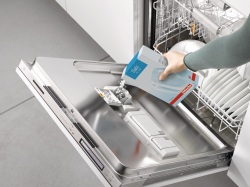With the many water shortages that have plagued South Africa of late, there has been a lot of focus on ways to save water in the home.
 All dishwashers are graded from A+++, which is the most efficient and cheapest to run, through to D, which is the least efficient.
All dishwashers are graded from A+++, which is the most efficient and cheapest to run, through to D, which is the least efficient.Most homeowners are familiar with the obvious offenders - don’t water your garden, don’t fill your pool, shower instead of bathing. However, few are well versed on how choosing a water-saving dishwasher can help with saving water.
Liam Gawne, from Miele, says using a water-saving dishwasher can help save thousands of litres of water every year, which is not only good for the environment, but also good for your pocket.
He says saving water is not just about using this precious resource carefully, but also has a ripple money-, water- and energy-saving effect.
“Saving water helps reduce water and wastewater treatment costs, and the amount of energy required to treat, pump and heat the water. This in turn lowers the energy demand, which helps prevent air pollution,” he says.
As South Africa’s population continues to grow, demands on our precious water resources increase. Combine this with an already stressed water supply, this means that our water resources should be used with care.
Today, there are many ways to use water more efficiently in our homes without having to make uncomfortable compromises. In fact, homeowners that have installed water-efficient plumbing solutions and appliances in their homes, can save up to 30% on indoor water use annually, and yield substantial savings on water, sewer and energy bills. One way to start saving today is to invest in a water-efficient dishwasher.
 Dishwasher technology has made great strides over the last decade, and any high-end model should include several innovations that reduce energy and water consumption, while simultaneously improving performance.
Dishwasher technology has made great strides over the last decade, and any high-end model should include several innovations that reduce energy and water consumption, while simultaneously improving performance.Buying a water-efficient dishwasher
If you are still of the opinion that washing by hand is more water-efficient than using a dishwasher, then think again.
Washing by hand may be quick and easy for a few dishes, but it won’t always save water when compared to a fully-loaded dishwasher. Aside from the extra effort, it would be virtually impossible to wash up to 130 items using 6.5 litres of water. This is what a water efficient dishwasher is able to achieve, plus it does all the hard slog for you.
Liam shares the following tips for homeowners who are looking to invest in a water-efficient dishwasher…
1. Check the energy rating
This is imperative - the EU energy label is found on all new dishwashers at the point of sale and provides a good indication of how much energy and water a model typically uses.
All dishwashers are graded from A+++, which is the most efficient and cheapest to run, through to D, which is the least efficient.
2. Look for added energy- and water- saving features
Dishwasher technology has made great strides over the last decade, and any high-end model should include several innovations that reduce energy and water consumption, while simultaneously improving performance.
Aside from the standard functions, a quality water-saving dishwasher should offer a range of other eco-friendly features.
 Although compact dishwashers are suitable for single-living, it is important to bear in mind that if you operate a compact model more frequently, over time, you may actually use more energy than you would using a standard model.
Although compact dishwashers are suitable for single-living, it is important to bear in mind that if you operate a compact model more frequently, over time, you may actually use more energy than you would using a standard model.One such feature is automatic load recognition technology, which automatically adjusts water and electrical consumption to suit the amount of dishes in the machine. This makes it viable to use the dishwasher, even when it is only half full.
Some other features include SmartStart technology, which allows the machine to switch on automatically when the electricity tariffs are least expensive, while the EcoFeedback technology shows you the estimated consumption on the machine’s display so that you can keep track of the amount of energy and water is being used.
3. Choose the right size
Standard dishwashers are designed to hold up to 14 international place settings, which is the ideal size for family requirements.
There are more compact models that are currently available on the market which can hold between six and eight place settings. Although these are suitable for single-living, it is important to bear in mind that if you operate a compact model more frequently, over time, you may actually use more energy than you would using a standard model.
4. Choose a dishwasher with advanced technology
Added technology will make your dishwasher more efficient, convenient and easier to use.
It is imperative to choose a dishwasher with soil sensors that test how dirty dishes are throughout the wash and adjusts the cycle to achieve optimum cleaning and minimum water and energy usage.
 A dishwasher with different cycle options allows you to adjust the programme to suit the dishes inside the machine.
A dishwasher with different cycle options allows you to adjust the programme to suit the dishes inside the machine.Other technological advancements recommended could include improved water filtration, which removes food soils from the wash water allowing efficient use of detergent and water and more efficient jets, which use less energy to spray detergent and water when cleaning.
Additional features could include innovative dish rack designs that maximise cleaning and capacity by strategically positioning the dishes.
5. Choose a dishwasher with several wash cycle options
This allows you to adjust the programme to suit the dishes inside the machine. For example, if your dishes are only slightly soiled, then you can use a light or energy-saving wash cycle, which uses less water and operates for a shorter period of time.







